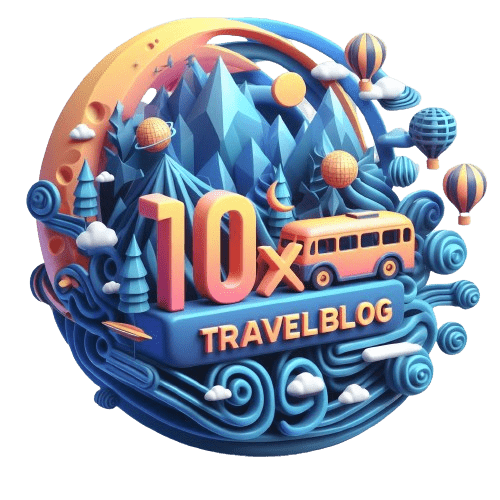Our experience exploring one of the most beautiful coastal destinations in the world was phenomenal. This is what it’s like to spend 3 days kayaking in Abel Tasman National Park.
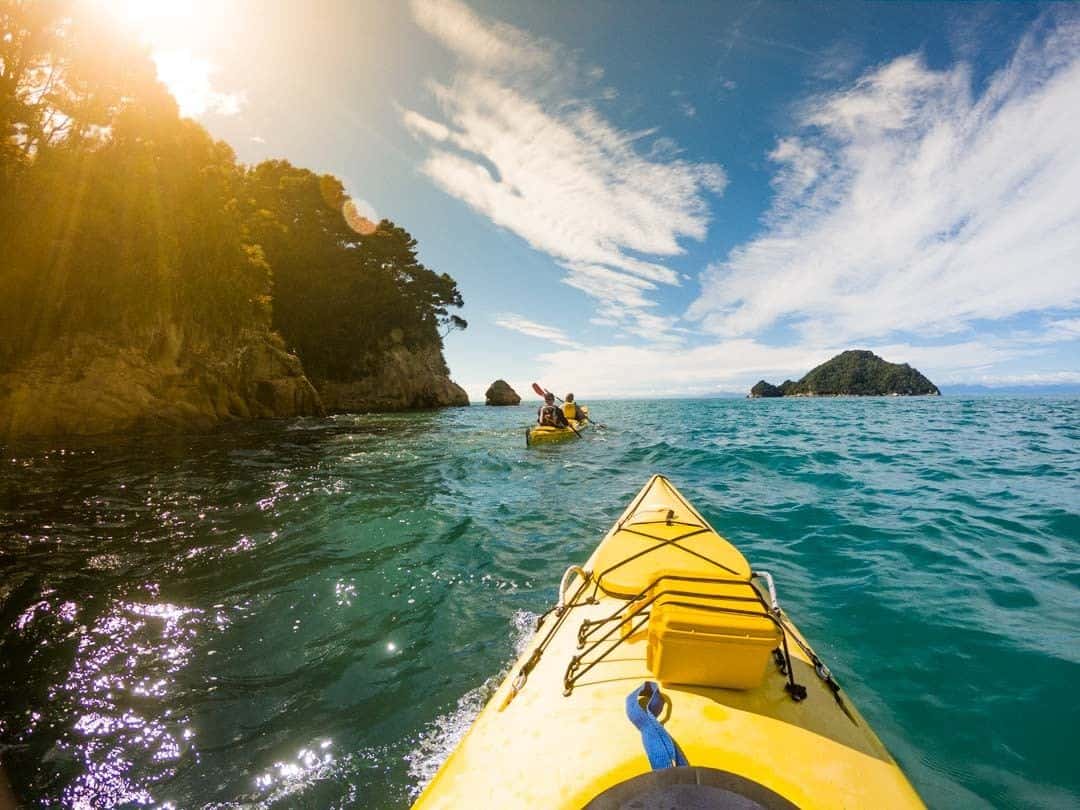
New Zealand is known for being one of the most beautiful nations in the world, home to dramatic mountain peaks, hanging glaciers, sprawling thermal hot springs and lush rainforests.
Travellers come from far and wide to hike the Great Walks, ski down crazy slopes, jump off of bridges and climb steep cliff faces.
Much to our surprise it also happens to have some of the best postcard-perfect beaches of anywhere we’ve ever seen.
After touching back down in Australia for a few months we were longing for some adventure, and being this close to New Zealand got us desperate to cross the ocean again and check it out.
Check out our Travel to New Zealand guide.
During our research of epic places to visit we came across the famous Abel Tasman National Park, the most popular park in the country, and instantly wanted to see it for ourselves.
Rather than being covered in jagged peaks and rugged valleys, Abel Tasman National Park looked like a tropical paradise, with pristine islands covered in dense rainforest and a turquoise sea lapping gently against white sand beaches fringed with palms.
Of course this being New Zealand, the gorgeous beaches weren’t places to laze in a hammock with a cocktail in hand – this was a place to have an adventure.
Two of the main ways to explore Abel Tasman are by land, with the famous 60km Abel Tasman Coastal Track taking up to 5 days to complete, or by sea kayaking.
Having done a lot of multi-day hikes in our lives we thought it’d be fun to mix it up and do something different. We had sea kayaked before, although never for more than a day at a time, so thought with our lack of experience it’d be best to join a professional tour operator in Abel Tasman.
Check out our video from our time kayaking in Abel Tasman National Park in New Zealand!
By far the best tour company in the Abel Tasman region is Abel Tasman Kayaks, so we reached out to them and asked what the best options would be for us.
They offer everything from single-day ‘freedom kayak’ options, right up to mammoth 5-day guided kayaking trips. We had the time, but as it was getting late in the season they weren’t running the 5-day one when we would be there.
On their advice, we decided to spend two days hiking on the Abel Tasman Coast Track and camping independently in the national park, then joining them for their classic 3-day kayaking tour.
They told us they could organise one of their private water taxis from their office at Marahau (which is also the launching point for most adventures in Abel Tasman National Park) to take us to Totaranui, the campground at the end of the road.
We’d be left to our own devices for two days, then would meet our kayaking team back at Totaranui to start the paddling adventure.
Based on local recommendations we jumped on the Department of Conservation website and booked one night at Mutton Cove (a place the guys at the kayaking centre claimed was one of the most beautiful spots in the entire park), and Anapai, a quieter beachside campsite close to Totaranui.
The Abel Tasman Coast Track covers 60km of stunning coastline in the park, so we just tackled a small section of it.
With the logistics taken care of, now all we had to do was get to Abel Tasman National Park!
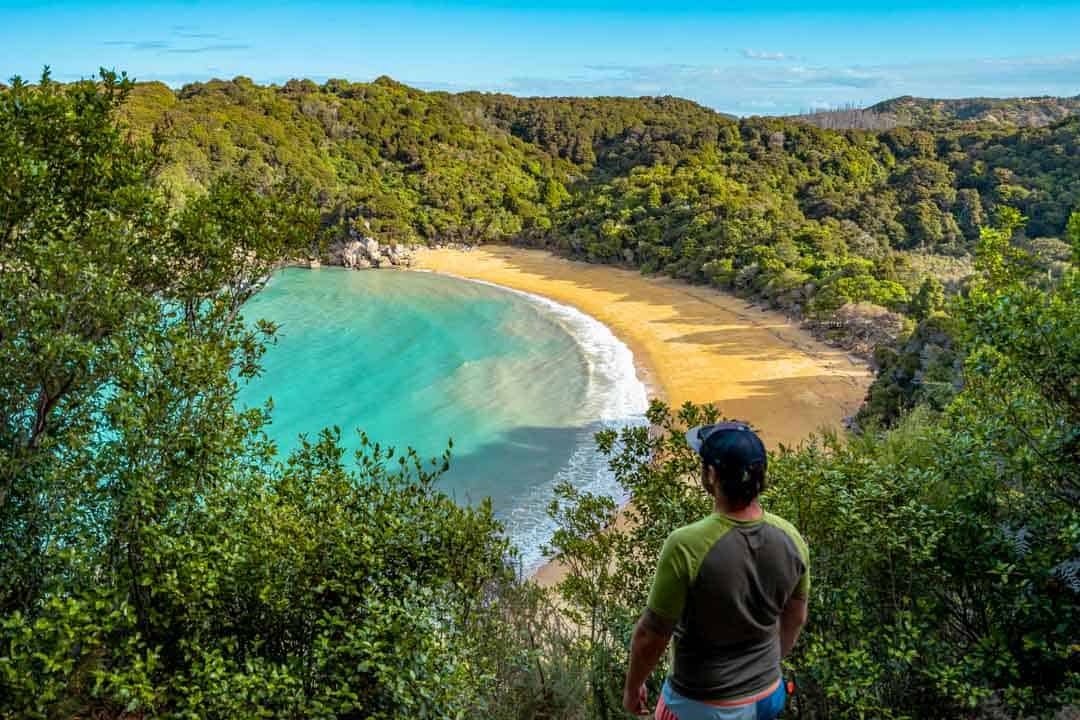
Before The Paddle – Hiking In Abel Tasman
After a few great days in Christchurch hanging with friends we jumped on a bus and headed up to the funky town of Nelson in the north of the South Island for the night.
The team at Abel Tasman Kayaks (ATK) had organised for us to get a transfer from our hostel right to their office, the launching point for adventures in Abel Tasman National Park, at Marahau.
When we got there the place was a hive of activity, with dozens of excited travellers getting kitted up for the various guided hiking and kayaking trips that ATK organises.
We checked in at the front desk and dropped off the gear we didn’t need for the next 5 days in their secure locker room, such as our laptops and non-hiking clothes.
With our backpacks loaded with camping and camera gear we jumped in a bus and drove out to meet the water taxi.
The 90-minute ride to Totaranui was absolutely sensational, with the boat driver ‘Cuzzy’ (a hilarious local) dropping off passengers in spectacular coves, and following the coastline in search of penguins and seals, while cracking jokes the whole way.
We couldn’t believe the shades of blue that were glimmering in the mid-morning sun as we cruised along towards Totaranui. When we finally arrived we disembarked, said bye to Cuzzy, and got ready for our Abel Tasman hike.
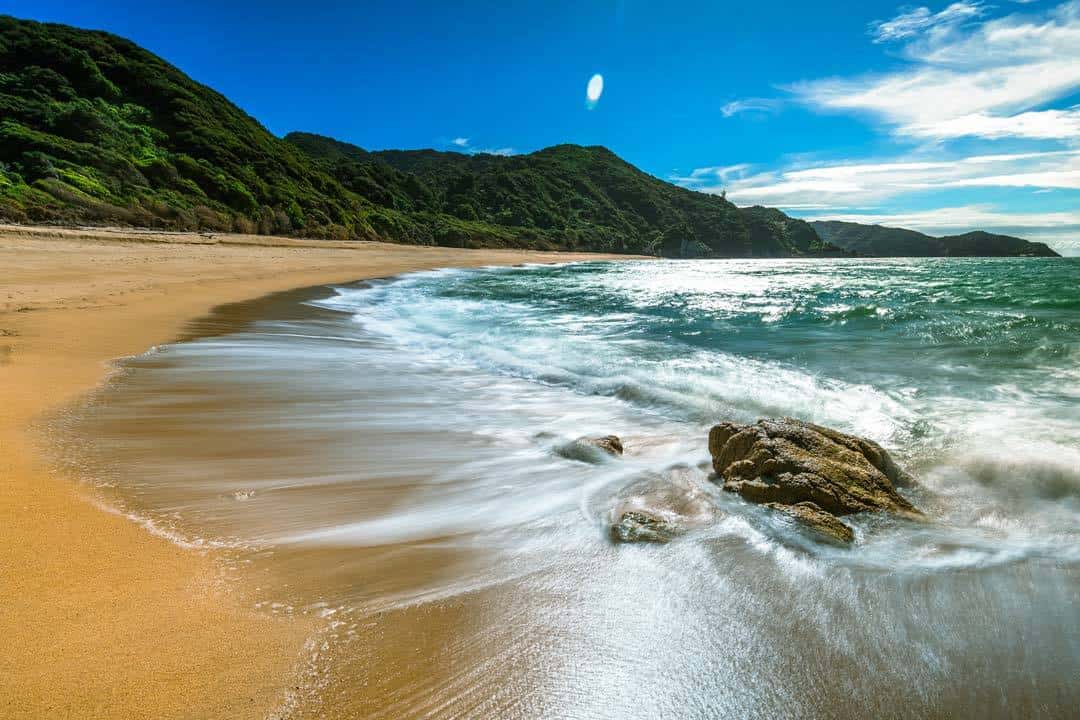
We took the long way to Mutton Cove via Gibbs Hill, a 13km track that climbs through beautiful forest and offers splendid views over the coast.
It was about 4pm when we wandered into Mutton Cove, and our jaws instantly dropped. As far as campsites go, this one is pretty remarkable.
On either side of the beach magnificent rocky headlands rise up, and the forest reaches right to the edge of the sand. We pitched our tent, went for a swim to wash off the day’s sweat, and got chatting with the 5 other campers that were also making this home for the night.
After we cooked dinner one of the couples lit a fire in the pit and we sat around roasting marshmallows and sipping on wine before calling it a night beneath the incredible glow of the Milky Way.
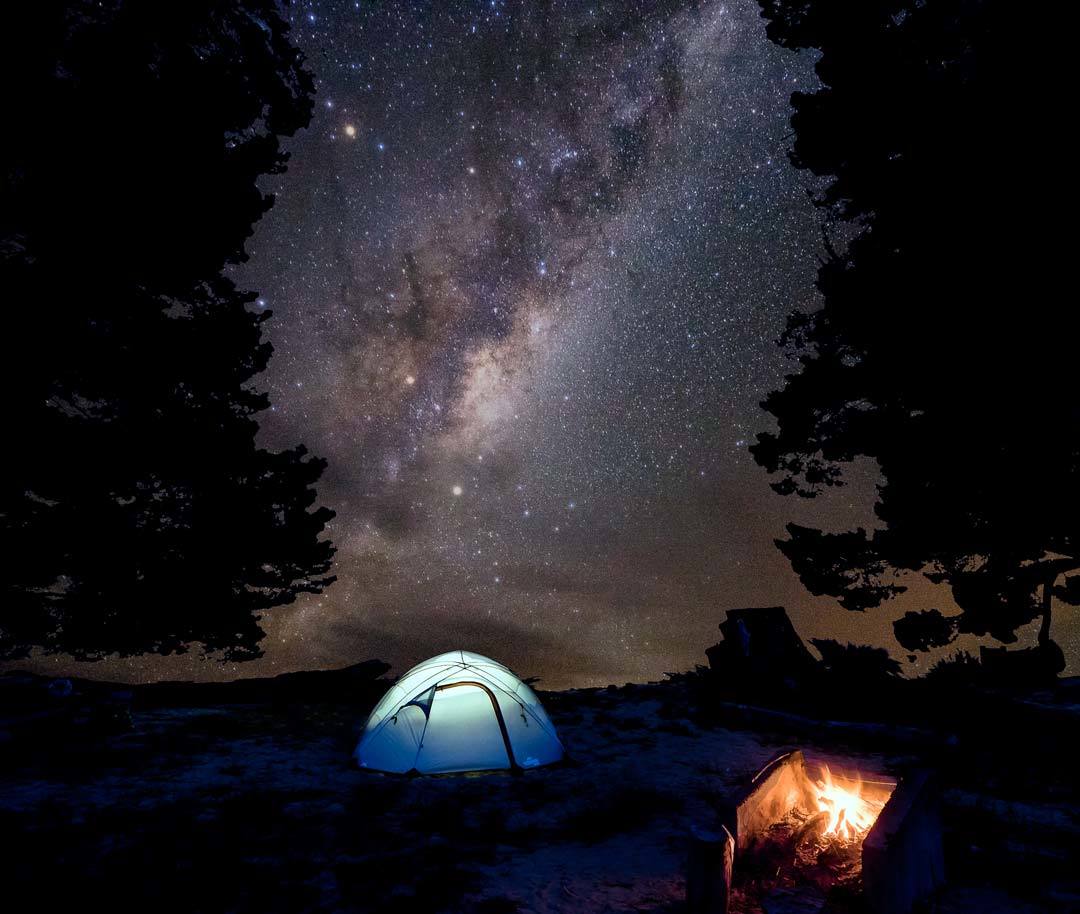
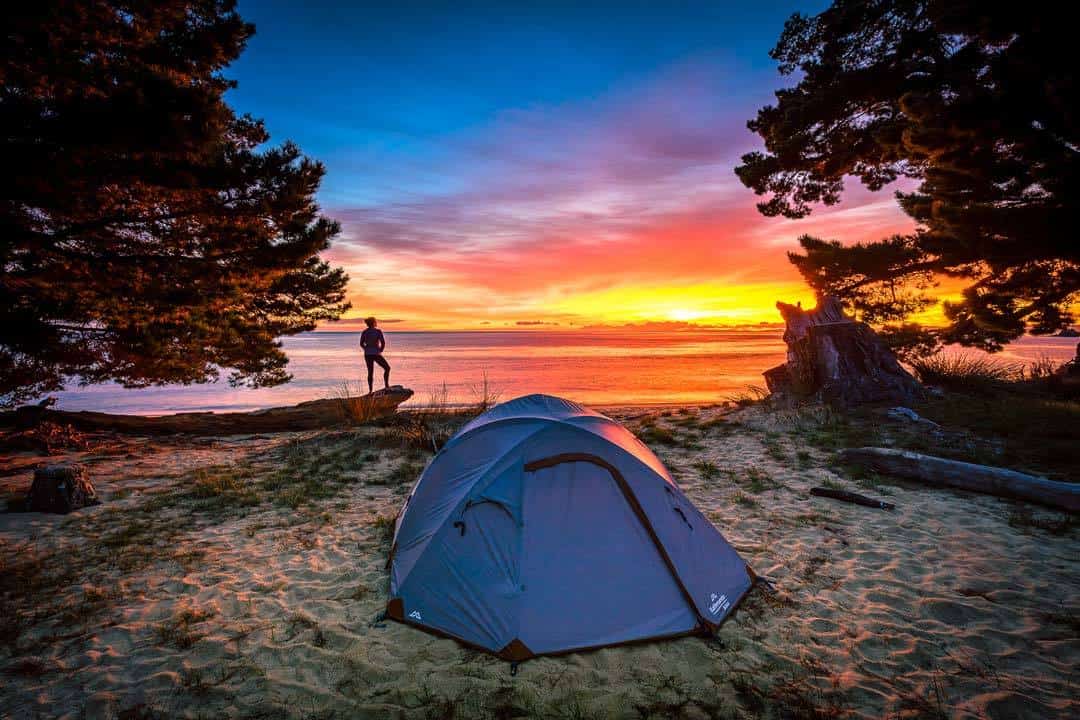
The next morning we only had a short walk to Anapai, so took our time packing the tent and enjoyed a cup of coffee on the beach with no one else around.
Around 10 we started walking the coast and arrived at Anapai much quicker than we expected, in less than an hour. Our original plan was to have a leisurely day before the kayaking mission, but we had no idea we’d have hours to kill.
Not ones to complain about being in paradise with time up our sleeves, we pitched the tent again and went exploring in the rock pools to the south of the beach. When the sun was getting too hot we relaxed under the trees and listened to music.
We cooked an early dinner and headed off to bed, with the sound of waves lapping at the shore being our lullaby.
The following day we made our way to Totaranui by 9am and waited for the kayaking adventure to begin.
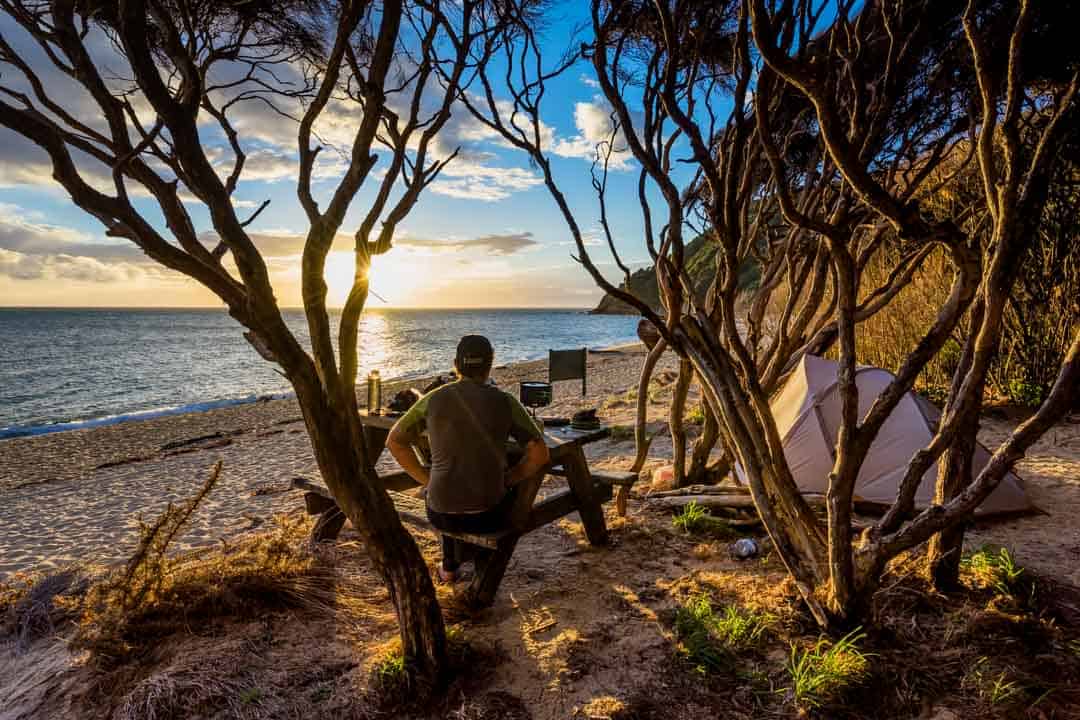
Kayaking In Abel Tasman National Park
Day 1 – The Adventure Begins
Normally the 3-day kayaking tour with Abel Tasman Kayaks starts right at Totaranui, but the wind and seas had picked up, so the company decided to start further down at Onetahuti, which was also going to be our campsite for the night.
The water taxi collected us and took us down to the next beach. The sun was shining, but as soon as we left the protection of Totaranui’s cove the waves started throwing our boat around. We instantly knew that kayaking around the headlands wouldn’t have been a good idea.
Once we got to Onetahuti we met our awesome guide Jezza (Jeremy) and the 5 other guests; two couples and a single guy Jay, who had come from Nelson that morning.
The two couples were doing an overnight trip, while Jay was doing the 3-day kayaking with us. We all started chatting and immediately got along.
Jezza gave us a detailed safety briefing on best kayaking techniques, how to get in and out of them properly, how to use the skirts, what to do in the unlikely scenario of a capsize, etc.
He then handed out life vests, dry bags and rain jackets, and told us the altered plans for the day.
As we weren’t paddling from Totaranui, we would use Onetahuti as our base, and kayak from there to some of Jezza’s favourite highlights, which actually worked in our favour.
Excitedly we packed our cameras into the drybags, loaded into the double kayaks and headed off.
It only took a few minutes for everyone to get into the swing of things. Before too long we were all in unison, making our way north surrounded by a sea of impossibly blue water and overgrown trees making the background.
There really is nothing quite like being out on the water on a perfect day in Abel Tasman!
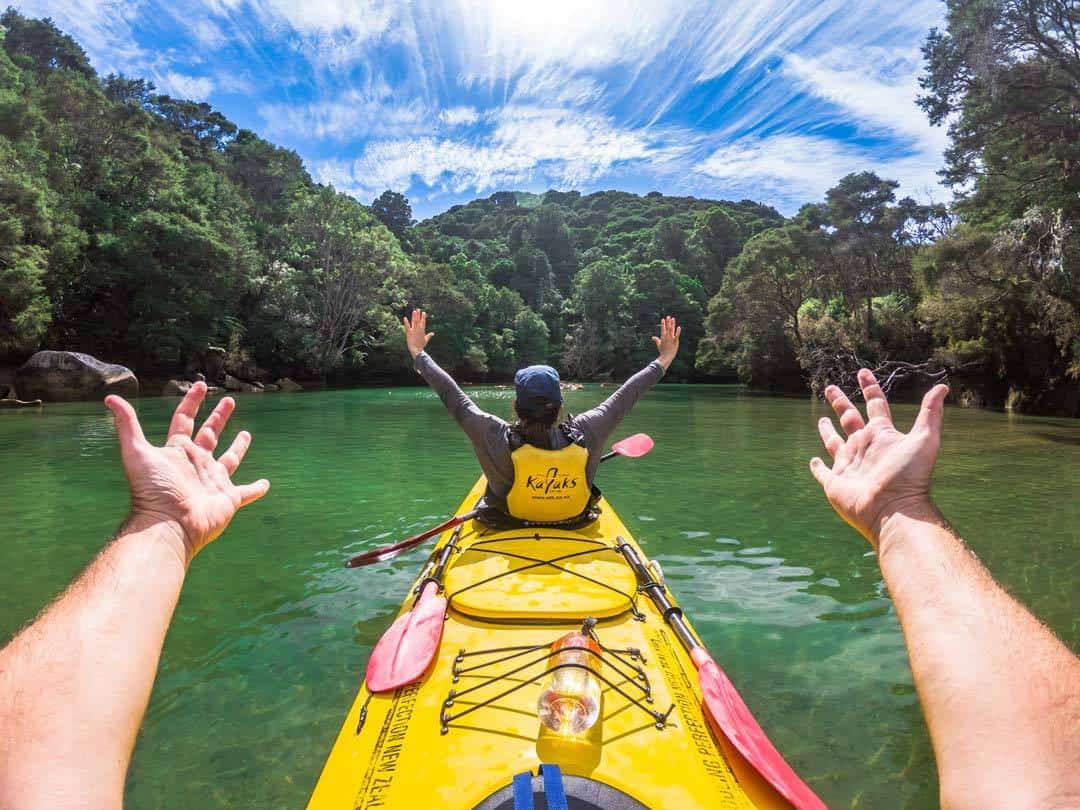
Careful not to get into rough seas, Jezza kept us close to the rising cliffs, not only offering us protection from the wind but also giving us a chance to look out for fur seals.
We were making our way to Shag Harbour, a place that Jezza claimed was one of the favourites in the entire national park, and that is only accessible by kayak at high tide. Our timing couldn’t have been any better, and if we had started our trip from Totaranui we would have missed our window.
Two large rocks gave us a narrow entrance into the harbour, which bent around to the right blocking any views from outside of what might be in there.
As we made our way into Shag Harbour we were well and truly blown away! It was like we had stumbled across a lost Amazonian world, with the clearest water we had ever seen giving the illusion of our kayaks floating on air.
All around us was the twisted beauty of untouched rainforest, with trees clinging to the side of boulders, and bird calls echoing off the cliffs.
We spent around 20 minutes paddling as far as we could go before shallow water halted our progress, then we simply sat in silence and admired the serene splendour.
All we wanted to do was jump out and go for a swim, but unfortunately the tide was dropping fast and none of us liked the idea of being stranded with the kayaks for a few hours, so we quickly headed back to the open sea.
Heading back south towards Onetahuti, Jezza led us to a secluded beach for lunch. We pulled up on the sand, jumped out and all had a good stretch.
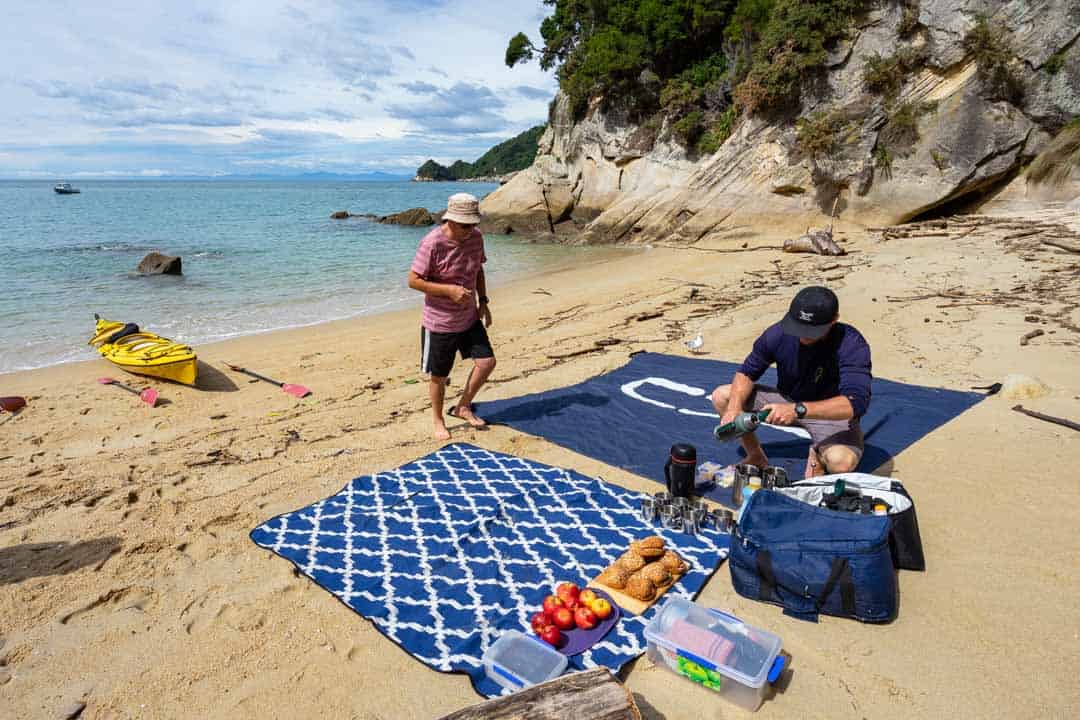
Jezza laid out a huge picnic blanket and immediately got to work preparing our meal. Fresh sandwich rolls were on the menu, with salads, meats and sauces to throw in them. Apples and chocolate cake were for dessert, as well as tea and coffee.
Chilling out on our own private beach, we shared stories with our new friends and relaxed. After an hour we packed all of the gear back into the storage of the kayaks and started off for the next destination.
Out from Onetahuti beach was a large island, and we made a beeline to the backside of it to paddle around.
The towering island was uninhabited by humans, but home to a large colony of New Zealand fur seals. Making sure we kept our distance, we observed the cute creatures swim around the shore and laze on the rocks.
As we paddled we also saw some of the amazing birdlife that live around Abel Tasman National Park. Cormorants, oystercatchers and of course gulls flew around the island, occasionally coming over to check us out.
The afternoon was getting on at this point so it was time to make our way back to the campsite.
As we got back we dragged the kayaks up well above the high tide line, got changed and went for a walk around Onetahuti while Jezza prepared some snacks for us.
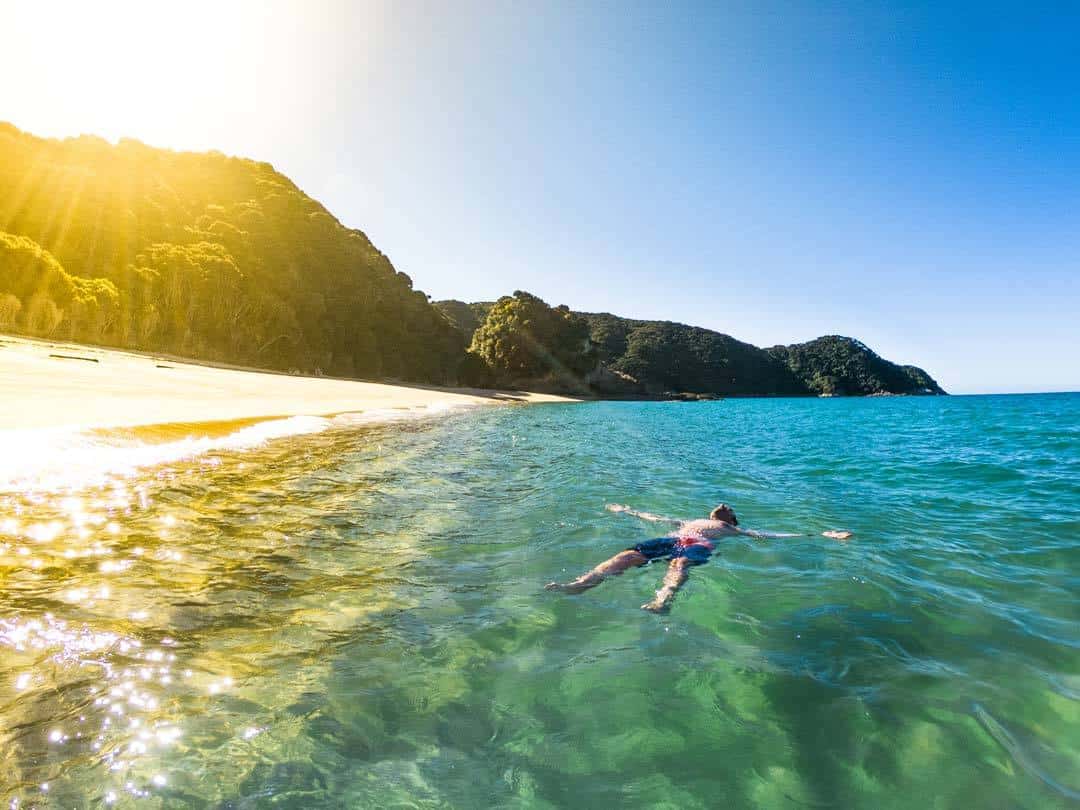
When we got back we got stuck into some cheese, crackers and fruit, when Jezza told us about a hidden little freshwater swimming hole to the back of the campsite. As were covered in salt, we had to go check it out and wash ourselves off in the freezing water.
Clean and feeling fresh we got back just in time for Jezza to start dishing up our delicious dinner – a vegetarian Mediterranean pasta. Not only was it tasty, but Jezza had also brought along some bottles of wine and beer for us to enjoy the meal with! What a legend!
As night fell we went for a walk to a nearby cave that was filled with glow worms. While not as impressive as the ones you get in other parts of New Zealand, it was still cool to see them.
Tired from the food and adventures, we retired to our tents around 9:30pm.
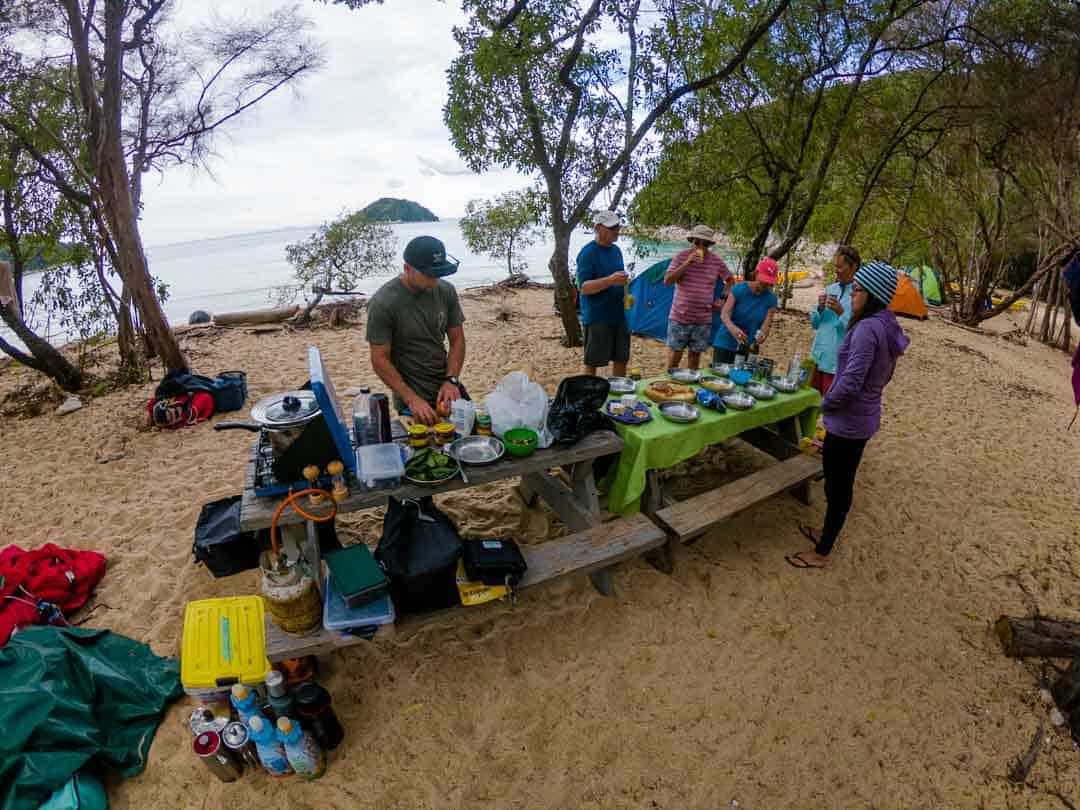
Day 2 – Plans Change: Walking To Bark Bay
We woke up to another beautiful day in Abel Tasman National Park, with the sun shining and minimal cloud cover around. Yet something was definitely different.
The wind had been smashing our tents all night, and as we popped our heads out of our tents we saw a substantial swell hitting the beach, and as far as the eye could see were white caps on the sea.
We started to pack up our tents then joined the rest of the group for coffee and breakfast, which Jezza had already prepped.
While we snacked on toast and cereal, Jezza was constantly on the radio, and he eventually told us that the seas were extremely rough and not safe for us to kayak to our next destination.
A plan was made for a water taxi to pick us and our kayaks up, and transfer us to Anchorage, the campsite for the night.
Nobody complained, as we knew our safety was the most important thing, and to be honest as much as paddling through the chop looked like a lot of fun, we could see that we’d tire very, very quickly in it.
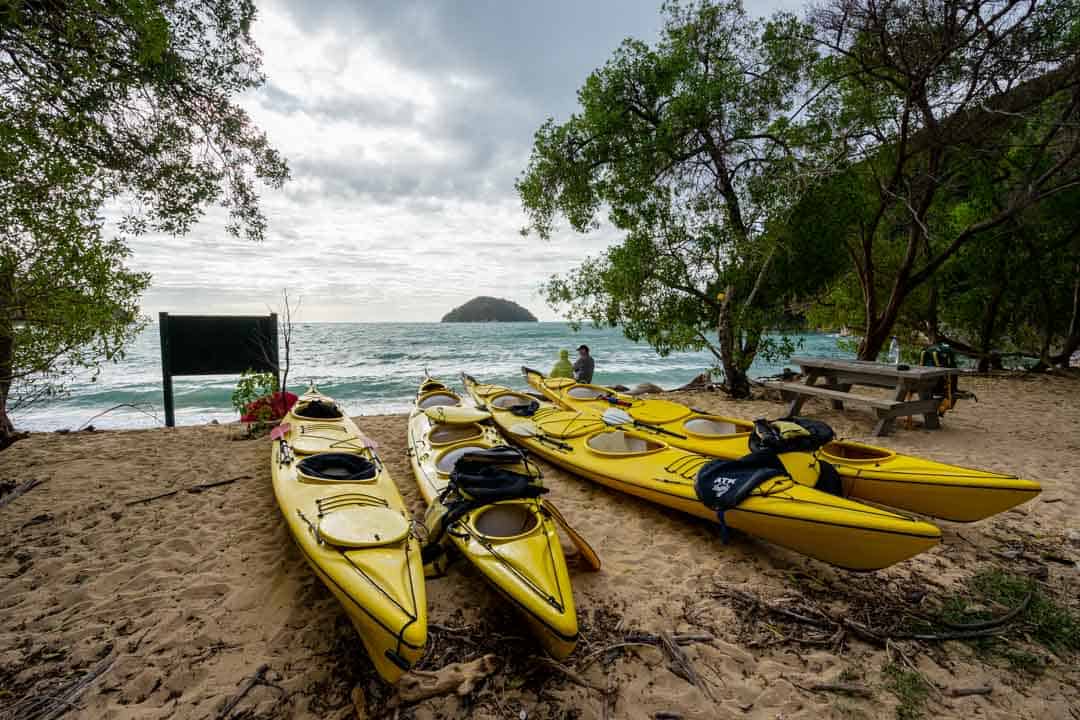
A few other campers and kayakers who had made it to Onetahuti independently were looking concerned about the seas, so Jezza organised the public water taxi to come and collect them as well.
As the water taxi came in a huge wave slammed it into the beach, bogging it on the sand. We all ran out and helped get the taxi back into the water, but it was clear that the seas were just getting stronger and stronger.
Jezza called a team meeting and said that as Onetahuti was fully exposed to the weather it might be some time before the next water taxi felt safe enough to come in, so with everyone agreeing, we decided to hike the 5km to Bark Bay, which was much more secluded.
We left our gear with the kayaks, packed up the cameras, and started walking.
At first we were a little bit bummed to be missing out on the morning kayak, but as soon as we got in the forest and to Bark Bay everybody was amazed.
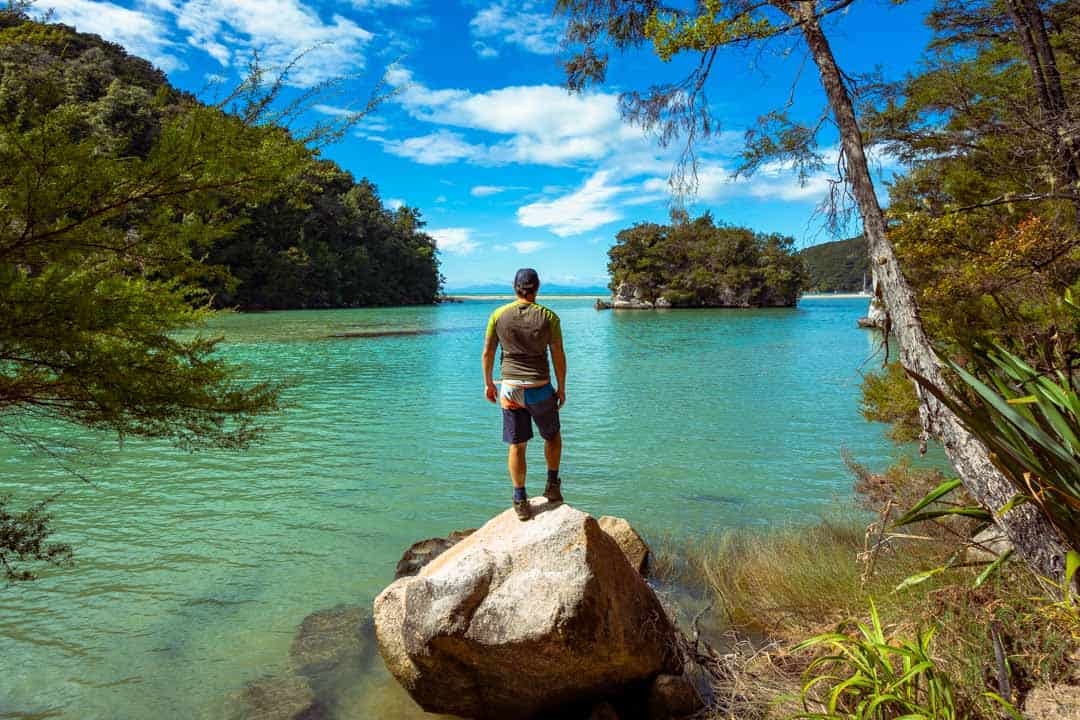
The bad weather meant we got the unique opportunity to mix up our activities, with a good old fashion ‘Abel Tasman kayak and walk’. And when you’re somewhere as beautiful as here, any opportunity to be in nature is welcomed.
The trail was easy, cutting through the forest away from the coastline, and we kept up the friendly chatter with our new friends
Once we made it down towards Bark Bay we stumbled across the famous suspension bridge that has been featured in so many photos of Abel Tasman National Park. If we had stuck to the sea we would have missed the gorgeous Bark Bay.
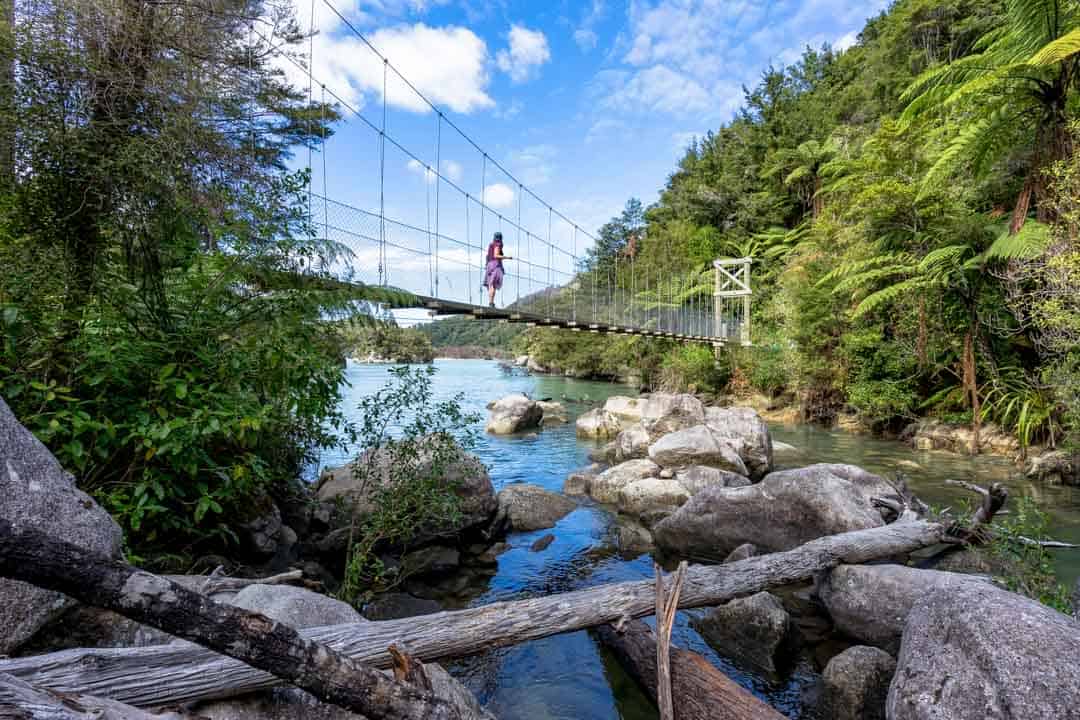
Bark Bay was of course absolutely stunning, with a large lagoon on one side and the ocean on the other. Jezza made us lunch and we sat in the shade listening to the waves and sipping on coffee.
Not long after Cuzzy and the water taxi arrived loaded with our kayaks and gear from Onetahuti. We jumped onboard and made our way towards Anchorage, our campground for the night, laughing away at Cuzzy’s constant banter.
Once again as soon as we left the safety of the Bark Bay harbour the waves picked right up and even the boat was bouncing pretty hard. We all knew that walking rather than kayaking in Abel Tasman was the best option for the day.
Anchorage was another one of those ‘pinch me, is this real?’ type of locations. A sprawling natural cove protected by rocky outcrops and fringing palms, with transparent blue water shining brightly.
It was here that the two other couples would head back to Marahau, with their 2-day Abel Tasman kayaking trip coming to an end.
Even though they didn’t get a chance to paddle today, they were thankful they got to see another part of the park they would have otherwise missed. We said our goodbyes, exchanged details, and off they went.
Once they left our remaining four went and set up camp. Anchorage is much busier than Onetahuti, with a kitchen shelter, toilet block and DOC hut all present. This meant there were dozens of other campers, but it was still easy to find a quiet spot near the beach.
Jezza started cooking dinner, and suggested that we all go for a walk to Te Pukatea Bay, which was only 20 minutes away.
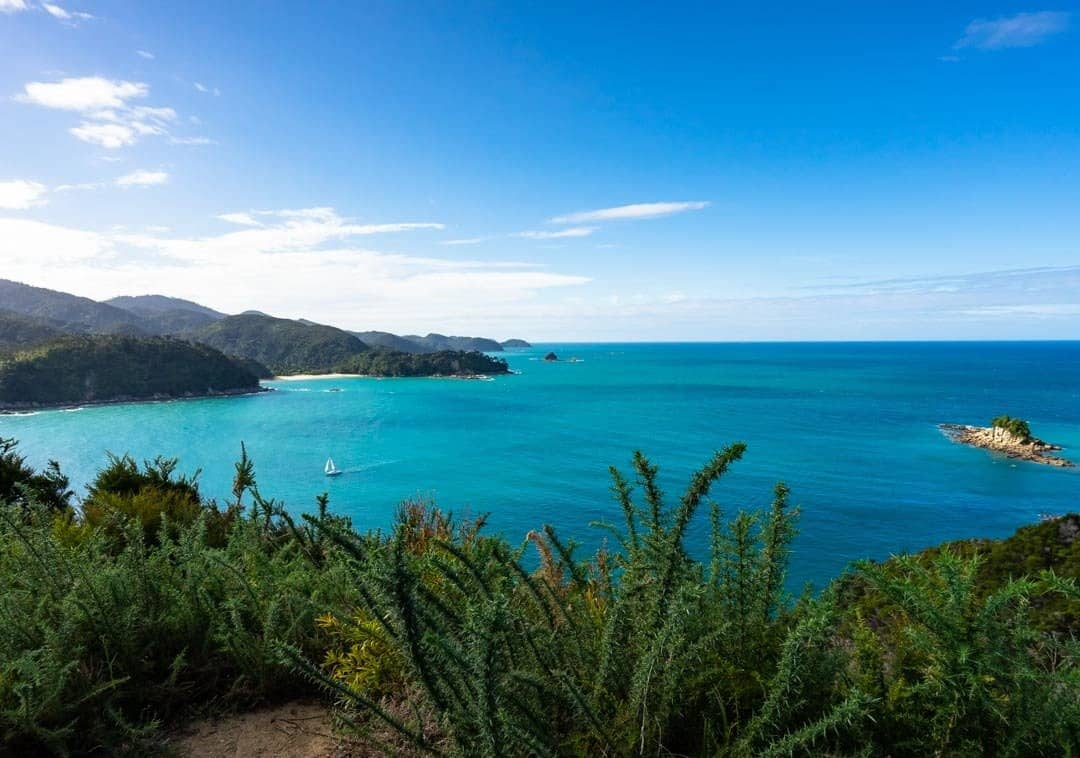
As we climbed up to the closest headland we were rewarded with majestic views over Anchorage and some of the islands of Abel Tasman National Park.
With vistas like this, it’s easy to see why this place is the most popular national park in New Zealand!
Te Pukatea Bay is a wineglass-shaped cove, and is the stuff postcards are made of. We dropped down to go for a swim, but unfortunately it was being battered by heavy winds, so we opted to skip it this time and head back to the shelter of Anchorage.
Jezza had almost finished dinner when we got there, a hearty chickpea curry, and he surprised us all again by producing a few more bottles of wine and beer than he had requested for the night.
Our small group ate, drank and were merry until the sun died down. We tried to make it to another glow worm cave, but the tide had risen and we unfortunately couldn’t get in without swimming.
The temperature dropped and soon we were all asleep in our tents.
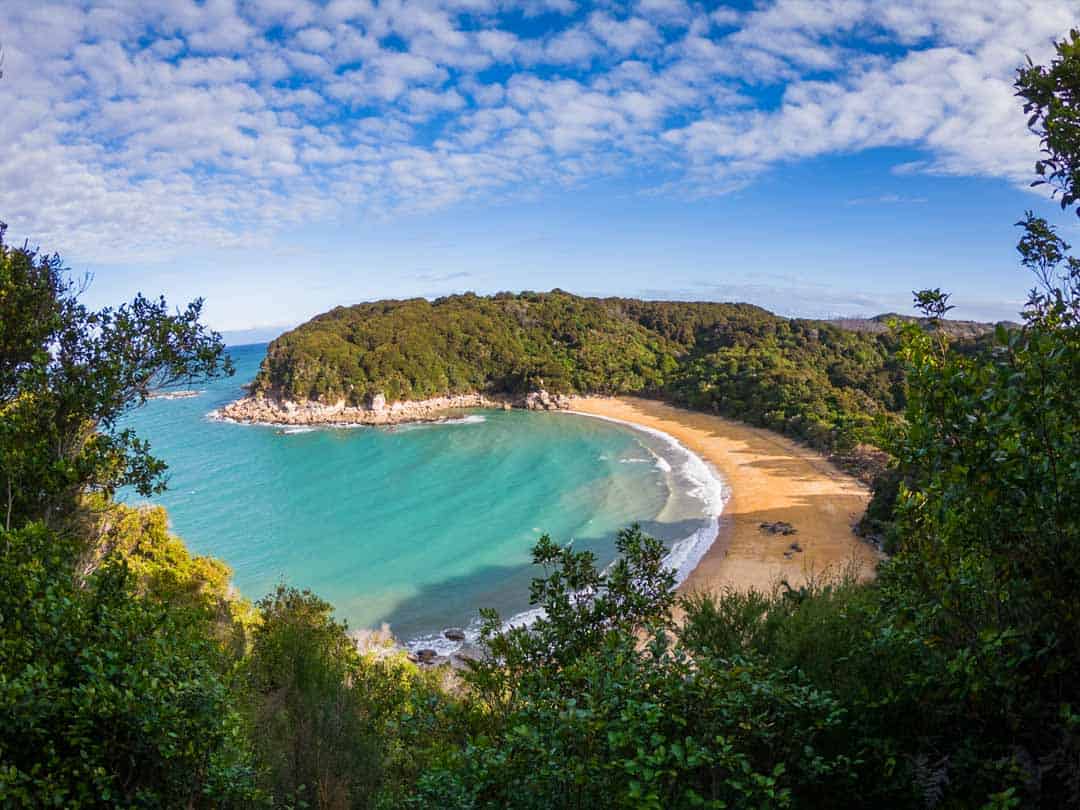
Day 3 – Anchorage To Marahau
We were stoked to see when we woke up that the weather had settled overnight, and we’d have no issues kayaking the final leg all the way to Marahau.
With just the 4 of us now it didn’t take long to pack up the tents, load up the kayaks and get onto the water.
Paddling out of Anchorage was beautiful, and as we had all settled into a decent rhythm Jezza decided to take us around the back of Anchorage and to a stunning little swimming hole that’s part of the Abel Tasman Coastal Walk.
He led us into a tiny cove and we parked the kayaks up on a beach. Walking barefoot, we made our way to a series of small waterfalls dropping into a clear natural pool.
Of course we had to go for a swim, and despite the freezing temperatures, it was a lot of fun sliding down the cascades and falling more and more in love with Abel Tasman National Park.
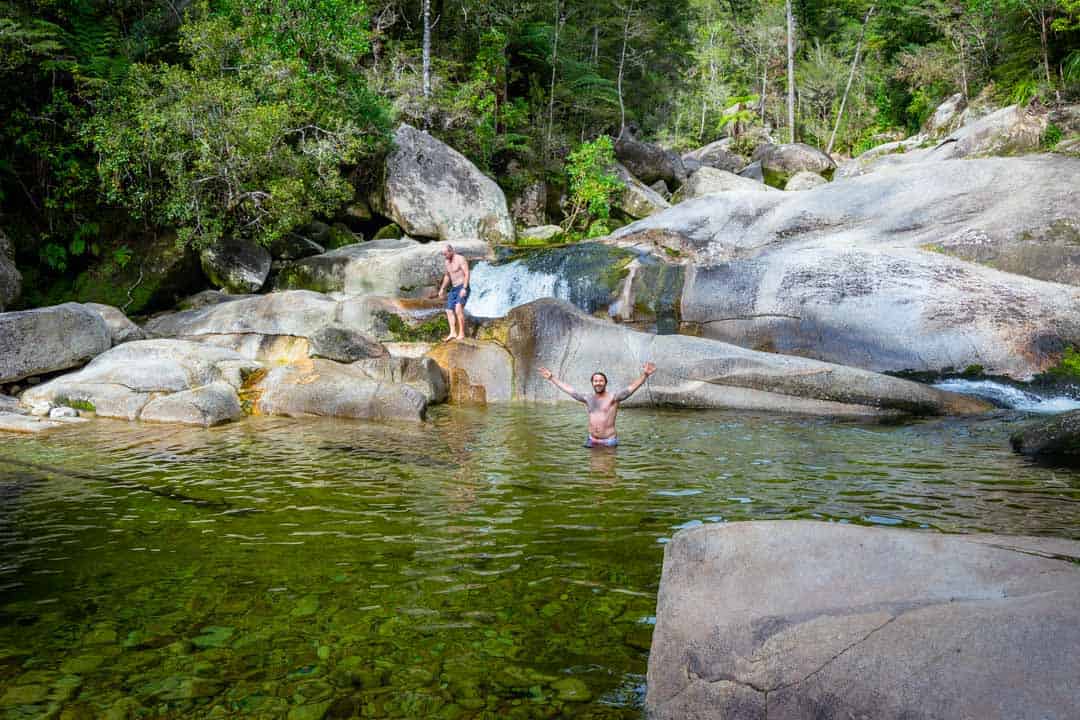
Once we’d collected our kayaks again we followed the coast to the south, with the final destination going to be the home base at Marahau.
Birds flew overhead, and we kept an eye out for any potential marine life that may make an appearance. It’s not unheard of for orcas to be in the channel around Abel Tasman National Park, but we weren’t so lucky on this day.
Today was going to be a short day, and with the pace we were making Jezza decided we had enough time to kayak around Fisherman Island, another one of his favourite spots.
Fisherman Island is also uninhabited, with dozens of fur seals chilling on the backside of it. We got as close as allowed to them and watched them go about their daily business.
There were a few picturesque inlets to explore, and soon we landed on a delightful little beach for lunch.
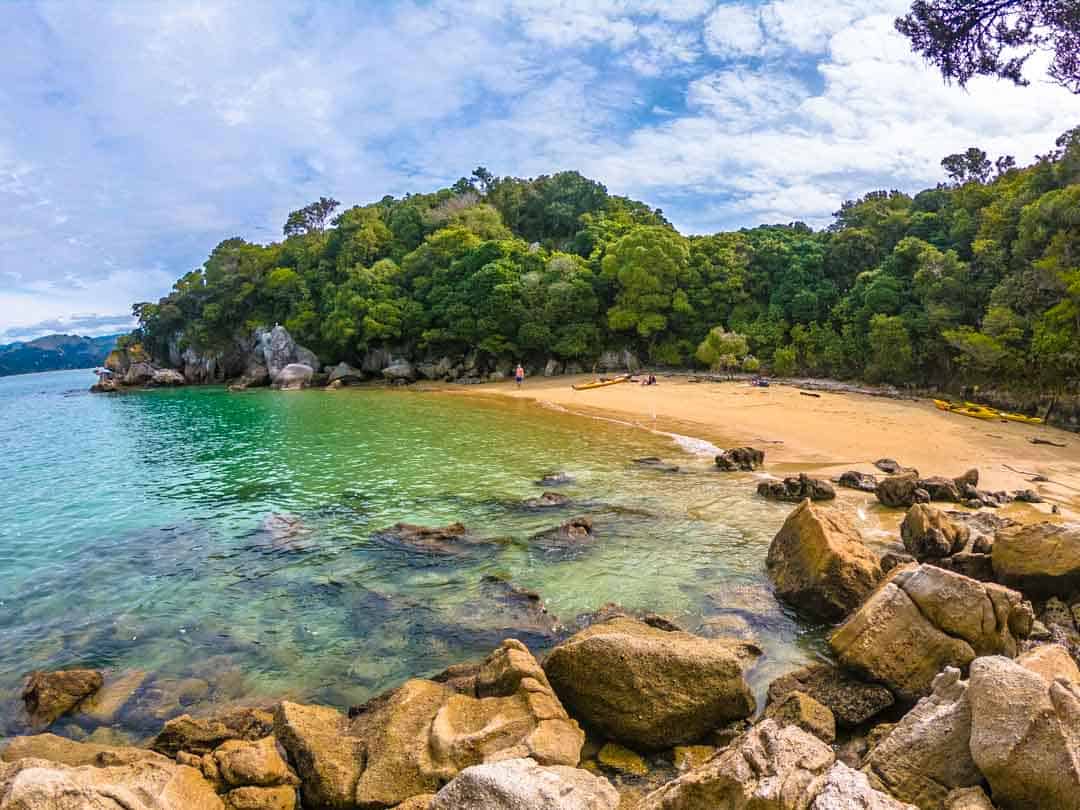
As we had made good time, that gave us just over an hour to make the most of our location before returning to Marahau and heading back to Nelson.
The tide dropped, meaning we could walk out to a little islet next to the beach, which had some fun little climbing options.
When it came to make our way back to Marahau none of us wanted to leave. We could have spent all day just laying on the beach and exploring Fisherman Island, but all good things must come to an end.
We made a beeline straight across the open water towards the port, charging through the light swell and wind.
As we came into Marahau the tide was right down, and not wanting to drag the kayaks any further than is needed, Jezza expertly led us through the narrow channels as far as possible.
Soon one of the staff members showed up in a tractor to collect us and our kayaks, and we made our way back to the headquarters.
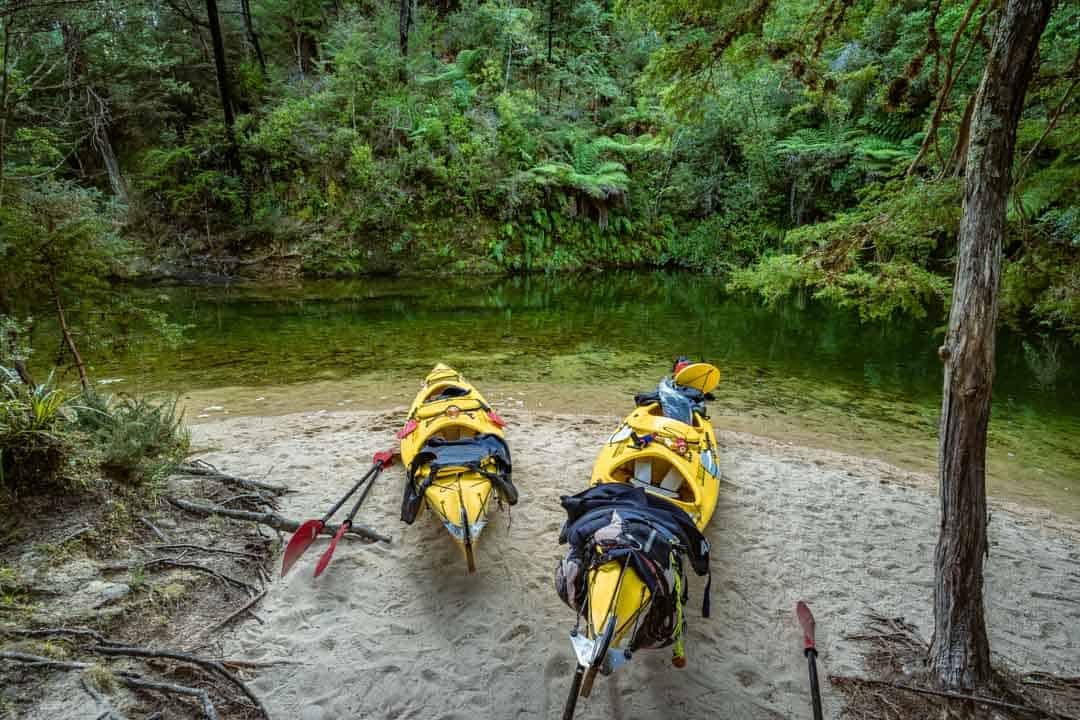
After 3 days out with the professionals, and 2 days on our own, it was sad to be finishing up our adventures in Abel Tasman National Park.
At HQ, Jezza gave us a debrief about where we had been over the last few days in Abel Tasman, and we cleaned out all of our kayaking gear and repacked our backpacks.
Having that kind of amazing experience together meant we’d become friends with Jay and our guide by the end of it, and even though Jezza does this day in day out all summer with hundreds of people, he was as excited as ever to share this trip with his guests.
We swapped details and promised to keep in touch. When we returned there were talks of secret coves and other hidden treasures that we could get out to, but we’ll have to save that for another day. For now it was time to jump on the bus and head back to Nelson.
Exploring the park with Abel Tasman Kayaks was one of the most captivating adventures we had done in a long time, and stuck with us as a real highlight in New Zealand.
If you’re looking to do something different on your next trip to the South Island, don’t miss hiking and kayaking in Abel Tasman National Park!
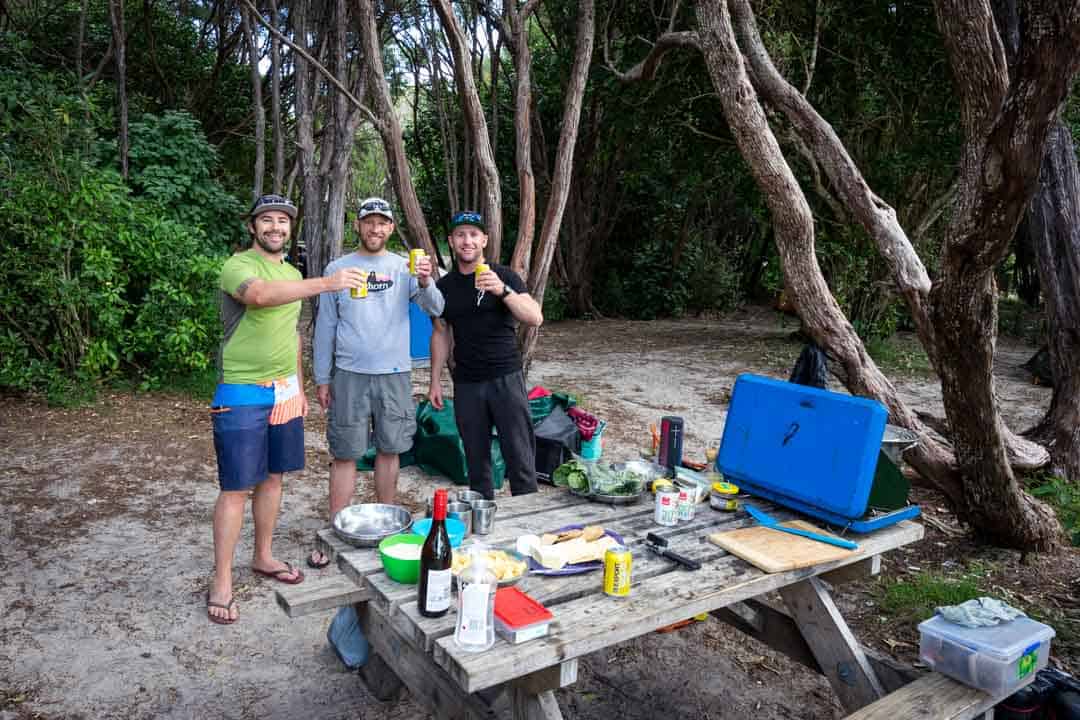
Tips For Kayaking In Abel Tasman National Park With ATK
Unless you’re very experienced with sea kayaking, you’re looking for some tips about what it’s like to paddle around Abel Tasman National Park.
Here are some of our thoughts and tips from our Abel Tasman kayak tour experience.
You Don’t Need To Be A Pro
While you do need to have a decent level of physical fitness to kayak Abel Tasman, you by no means need to be a professional sea kayaker to do it.
The ocean around Abel Tasman National Park is usually quite protected, and as you can see in our article if it does get too rough there are always other alternatives to explore that aren’t on the water.
Unless you’ve sea kayaked a lot though we highly recommend joining a professional tour operator such as Abel Tasman Kayaks.
They use top quality double sea kayaks with rudders, and it doesn’t take very long to get the hang of them.
Even if you’re travelling on your own you can still join one of their guided kayak tours. They’ll partner you up with somebody, or you can jump in with one of the guides, so you’ll always have someone with you on your kayak trip.
Bring Appropriate Clothing
Just like with any outdoor activity, it’s important to have the right clothing with you. Even in the middle of summer the weather can change quickly, and you need to ensure you won’t be caught out.
For a kayak trip in Abel Tasman we personally recommend having one quick-dry shirt to wear during the day, swimwear to wear underneath (obviously), a fleece in case the weather turns and dry clothes to change into at camp.
The company supplies good quality rain/wind jackets, so if you don’t have one it’s not a problem. They also give you a kayaking skirt (to keep splashes out while you’re paddling), life jackets, a dry bag for your clothing and a pelican case for your electronics.
Definitely bring a GoPro!
They supply all the camping and cooking gear except for a sleeping bag, but sleeping bags can be rented if necessary.
We brought our own hiking tent, but if you don’t have one the gear they use is high quality.
You Don’t Need To Bring Any Food
When you sign up for one of the Abel Tasman guided kayaking tours with ATK, you will be given all the food, water and tea/coffee you’ll need.
On the multi-day trips the guide even cooks up a proper feast for you, which we were amazed by. The meals are hearty, delicious, and vegetarian, and in our case Jezza did an awesome job at looking after the entire group.
If you’re the kind of person that gets hungry quickly though, or likes to snack on something during the day, bring some muesli bars, trail mix or nuts to get you by on your kayak tours.
Remember You Can’t Control Nature
Of course this is meant to be a fun adventure out in nature, and as such things can change at the drop of a hat.
You might not get beautiful blue skies every day, you might not get to see any wildlife, and sometimes the weather can get so bad you can’t actually go on kayak tours.
Just remember that this is all part of spending time outdoors, so keep an open mind on your kayak trip and be willing to go with the guide’s decisions in case they change plans.
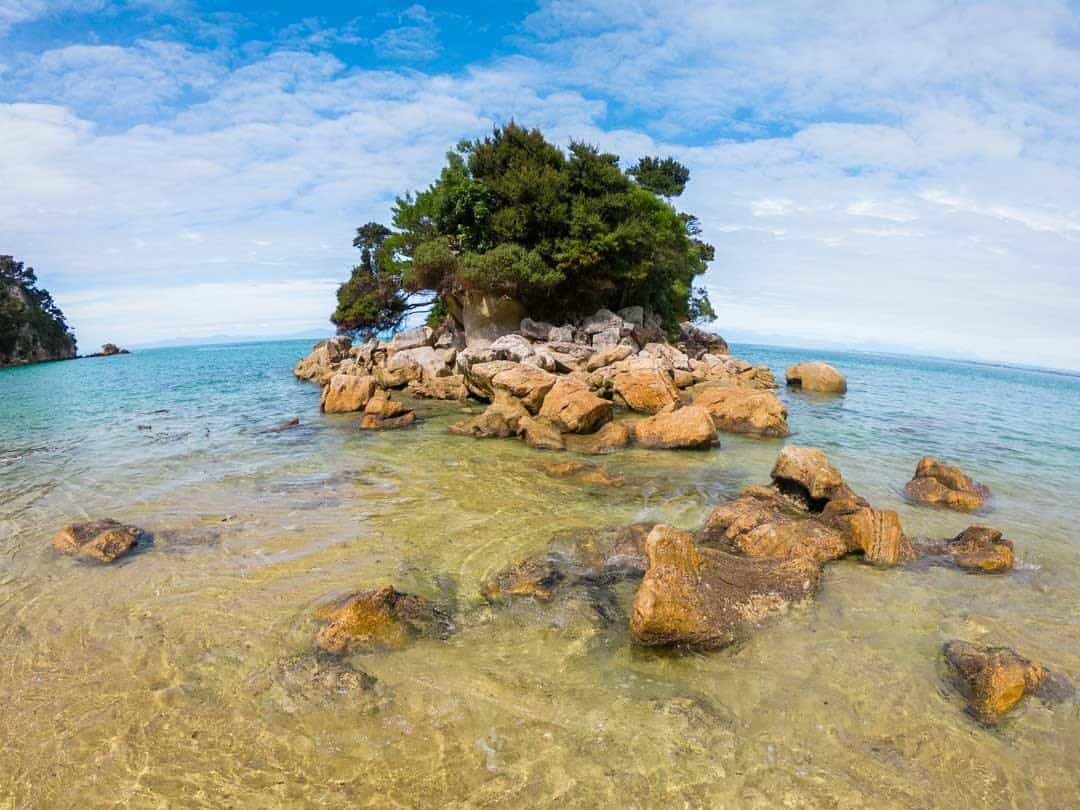
Our 3-day adventure was done in partnership with Abel Tasman Kayaks. All thoughts, opinions and hours spent paddling around in absolute paradise are, as always, our own.
